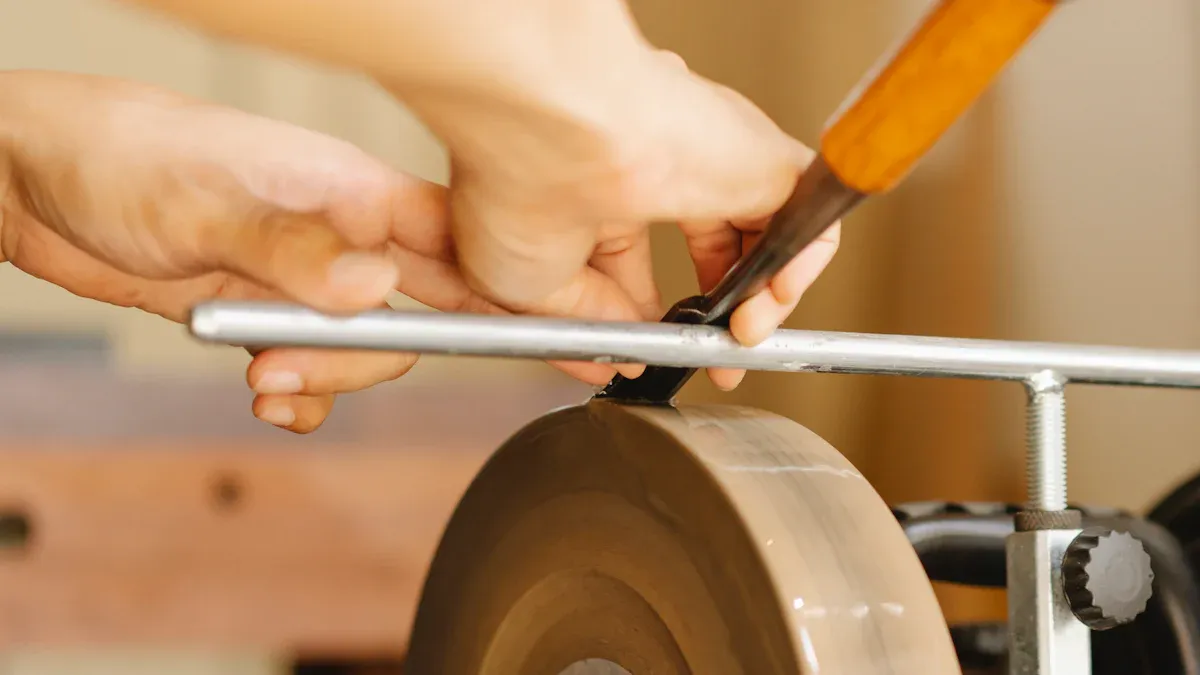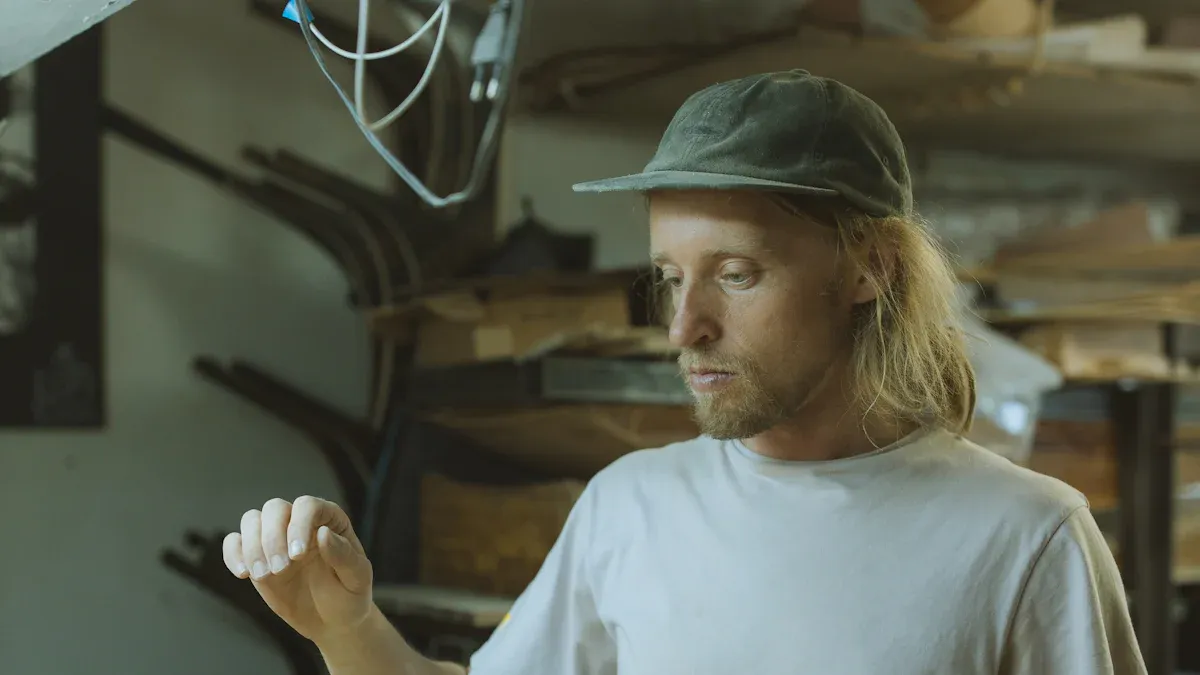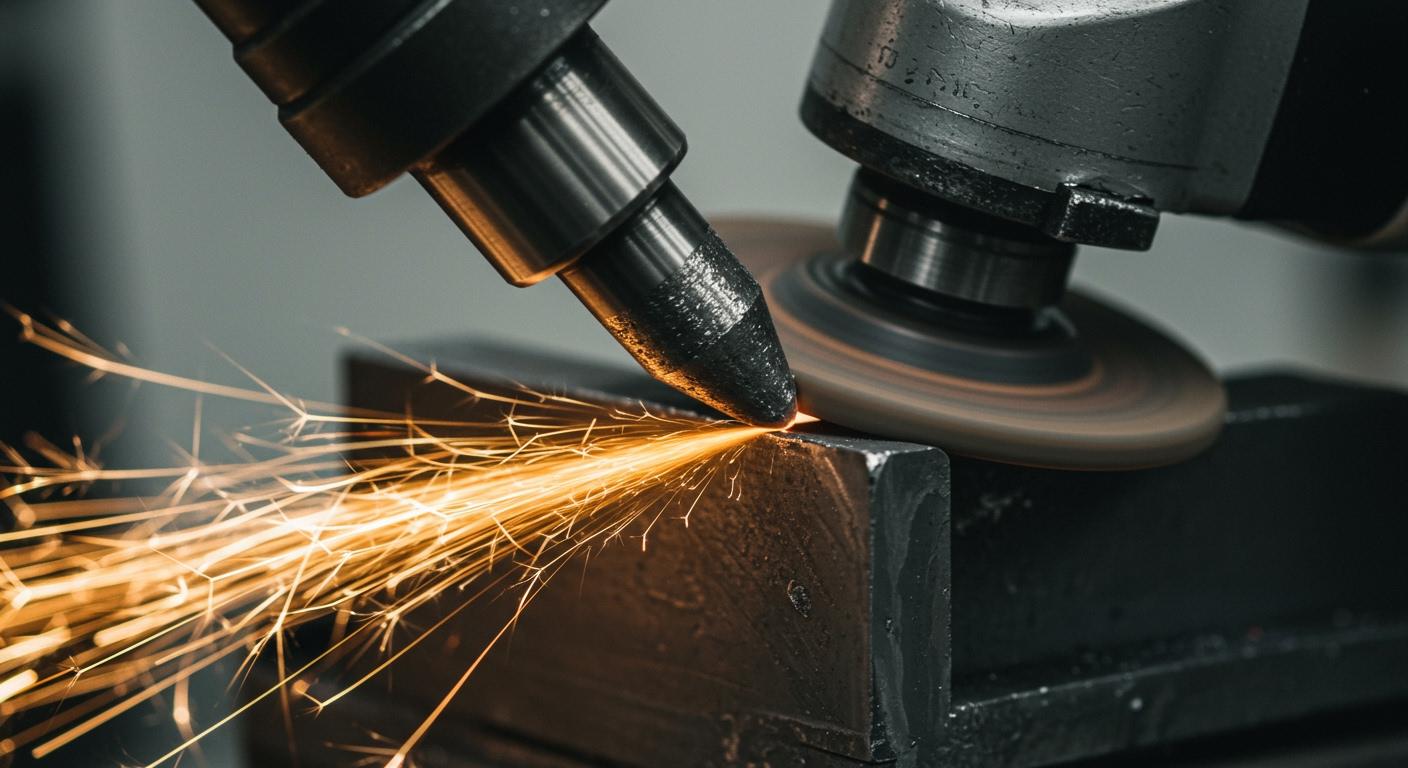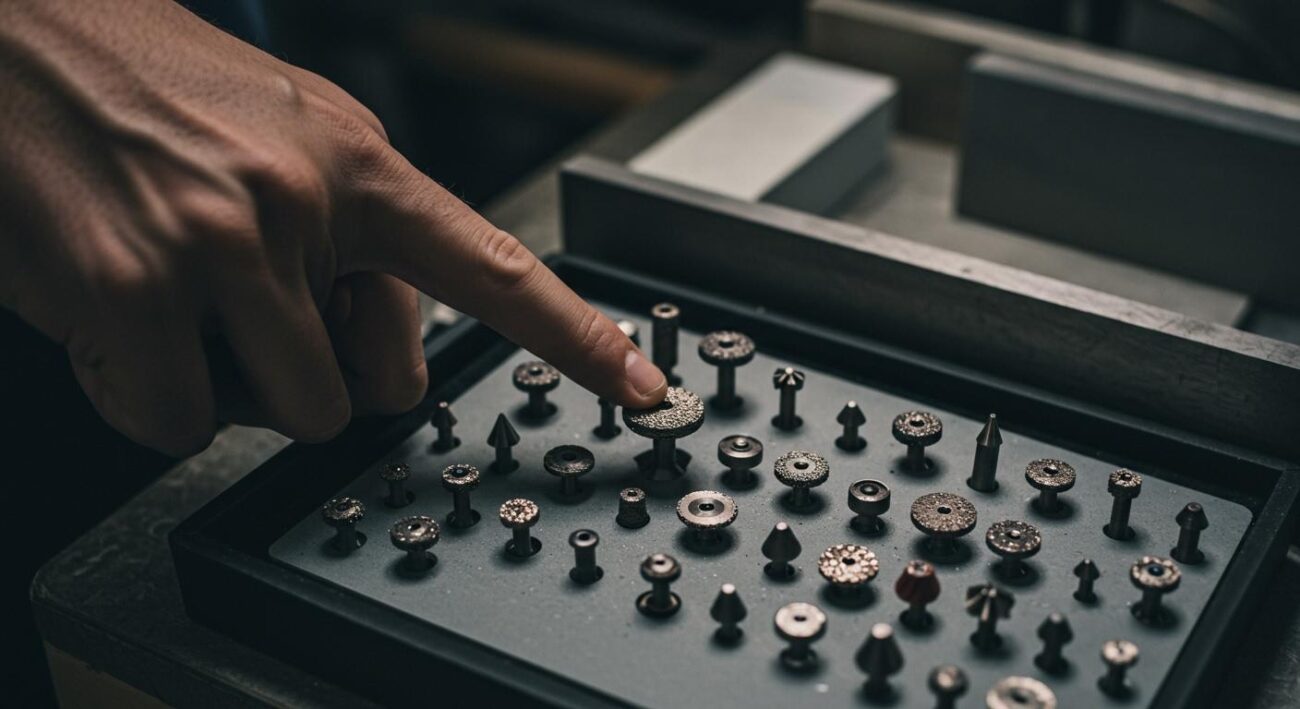You can master your diamond grinding pin with one simple rule. Combine high rotational speed with very light pressure. This principle is the secret to professional results. It allows the diamond particles to shear material cleanly. This method prevents heat damage and extends your tool’s life. You achieve a much smoother finish. Your grinding skills are valuable. The market for precision diamond tools is expanding quickly.
| Metric | Value |
|---|---|
| Market Size (2024) | USD 10.8 Billion |
| Forecasted Market Size (2034) | USD 19.5 Billion |
| CAGR (2025-2034) | 6.2% |
Key Takeaways
- Use high speed with light pressure for clean cuts and to protect your tool.
- Always use a coolant to prevent heat damage and keep your work clean.
- Keep the grinding tool moving to get a smooth and even finish.
- Work from coarse to fine grits to achieve a polished surface.
- Wear safety glasses and gloves to protect yourself while grinding.
Choosing Your Diamond Grinding Pin

Selecting the correct diamond tooling is the first step toward achieving a professional finish. The right tool improves your efficiency and the final outcome of your project. Your choice depends on the material, the desired finish, and the specific task.
Match Grit Size to Your Goal
You must match the diamond grit size to your objective. Abrasive grains are measured using standards like the US Mesh and the European FEPA systems.
- Coarse Grits (e.g., 60-80): These have lower numbers. You should use them for rapid material removal and rough shaping.
- Fine Grits (e.g., 400+): These have higher numbers. You need them for polishing, deburring, and creating a smooth surface finish.
Starting with the right grit saves you time and prevents damage to your workpiece.
Select the Right Head Shape
Diamond grinding pins come in many shapes. Each shape serves a unique purpose.
- Cylinders and Wheels: Use these for flat surfaces and straight edges.
- Ball or Sphere: These are perfect for concave surfaces and creating contours.
- Tapered or Cone: You can use these for reaching tight corners and detail work.
Choosing the right shape allows you to perform your grinding task with greater precision.
Understand Bond Types: Electroplated vs. Sintered
The bond holds the diamond particles to the pin. The two common types offer different benefits.
Electroplated Pins: These have a single layer of exposed diamond. They are excellent for intricate grinding on delicate materials like glass and ceramics.
Sintered Pins: These feature multiple layers of diamond fused in a metal matrix. They offer exceptional tool life for grinding hard materials like stone or concrete.
Opt for Quality with Aimgrind Diamond Tools
The quality of your diamond grinding pin directly impacts your grinding performance. A low-quality tool can cause vibration, leading to a poor finish. A specialized brand like Aimgrind provides high-quality diamond tooling you can trust. Aimgrind‘s diamond grinding tools undergo microscopic inspections to ensure a consistent diamond coating and a true shank. This commitment to quality reduces run-out and vibration. You get superior performance and durability for industries from glass processing to tool manufacturing. Investing in quality diamond tooling ensures you get the best results.
Mastering Your Grinding Technique

Proper technique transforms good diamond tooling into a high-performance system. Your control over speed, pressure, and movement directly determines the quality of your finish. You can achieve professional results by mastering a few key actions.
Use a Lubricant or Coolant
You should always use a lubricant or coolant when grinding. Wet grinding is not just a suggestion; it is essential for top-tier work, especially on brittle materials. A continuous flow of coolant provides several critical benefits. It prevents heat buildup at the contact point. This action protects both the workpiece and the diamond tool from thermal damage. It also clears away swarf and debris from the grinding area. This keeps the cutting surface clean and prevents micro-fractures in materials like glass and ceramics.
Pro Tip: Water works well as a universal coolant for many applications. You can also find specialized grinding fluids that offer enhanced cooling and lubrication for specific materials.
Let High Speed Do the Work
You must remember the foundational rule: high speed with light pressure. Let the rotational speed of your tool do the cutting. You should only apply enough pressure for the diamond particles to engage the material. Forcing the tool creates disastrous results.
Applying excessive pressure causes many problems:
- It generates extreme heat, which can damage the workpiece and cause premature diamond loss.
- It increases tool wear and can deform the pin.
- It leads to poor cutting quality with nicks and chips.
Your goal is to let the diamond grains shear the material, not scrape it away. Increase pressure gradually until you hear or feel the tool begin to cut effectively. This light touch is the key to a smooth finish and long tool life.
Keep the Tool in Constant Motion
You should never let the diamond grinding pin rest in one spot. Keep the tool moving across the workpiece in smooth, even strokes. This technique is vital for several reasons. Constant motion distributes heat evenly, preventing thermal damage. Efficient cutting from diamond tooling generates less overall heat, and keeping it moving ensures no single area overheats. This practice also helps you achieve a uniform finish without creating flat spots, grooves, or divots. A steady hand and continuous movement produce the best surface quality.
Work in Stages from Coarse to Fine
You cannot achieve a mirror polish in a single step. Professional grinding is a multi-stage process. You must work through progressively finer grits to refine the surface. A typical grit progression helps you remove material efficiently and then polish the surface smoothly.
For example, you might follow a sequence like this:
- Rough Shaping: Start with a coarse grit (e.g., 220) to remove material quickly.
- Smoothing: Move to a medium grit (e.g., 400-600) to remove the deeper scratches from the first stage.
- Pre-polishing: Use a fine grit (e.g., 1000-1500) to create a smooth, satin finish.
- Final Polishing: Finish with an ultra-fine diamond grit or polishing compound to achieve a mirror shine.
This staged approach to grinding ensures each step prepares the surface perfectly for the next, leading to a flawless final performance.
Maintenance and Safety Essentials
Proper maintenance and a commitment to safety ensure your tools perform well and you stay protected. You can extend the life of your equipment and achieve better results by following a few essential practices.
Prioritize Personal Safety
You must always prioritize your safety during any grinding operation. Flying debris and harmful dust are serious hazards. Inhaling dust from materials like fiberglass or metal can cause lung irritation and long-term organ damage. You should always wear the correct Personal Protective Equipment (PPE).
| Hazard | Required PPE |
|---|---|
| Flying Debris | ANSI Z87.1 Safety Glasses or Face Shield |
| Airborne Dust | NIOSH-Approved Respirator (N95 or better) |
| Excessive Noise | Earplugs or Earmuffs |
| Hand Injuries | Heavy-Duty Gloves |
Secure Your Workpiece
You must secure your workpiece firmly before you begin grinding. An inadequately secured piece can move unexpectedly. The grinding wheel can grab a loose workpiece, pulling it into the machine and causing serious injury. This movement also leads to uneven grinding, ruining your project with inconsistent edges. Always use clamps or a proper fixture to hold your material tightly in place.
The Role of Truing and Dressing
You need to understand the difference between truing and dressing to maintain your grinding wheel.
- Truing: This is the process of making the grinding wheel perfectly round and concentric with the spindle. The truing process corrects any run-out. You perform truing to give the grinding wheel its required shape. This includes profiling diamond grinding wheels for specific jobs. Truing is about geometry.
- Dressing: This process cleans the grinding wheel and exposes fresh diamond particles. Over time, the wheel’s surface can become loaded with debris. Dressing removes this buildup. Proper dressing creates sharp cutting edges for efficient cutting. You use a dressing tool for this task. Dressing your wheel is vital for performance. The goal of dressing is to restore cutting ability, while truing restores the wheel’s shape.
Key Distinction: Think of truing as shaping the wheel and dressing as sharpening it. Both truing and dressing are critical for precision work. You perform truing less often than dressing.
Clean and Inspect Your Pins
You should inspect your diamond grinding pin before every use. Look for signs of damage or excessive wear. A damaged pin can ruin a valuable workpiece. Regular cleaning is also part of good maintenance. You can clean a loaded pin with a soft aluminum oxide dressing stick. This dressing action gently removes debris from between the diamond grains, exposing the sharp edges underneath. This simple step of dressing restores the tool’s cutting efficiency and ensures a smooth finish.
You can master your diamond grinding pin. Success combines quality diamond tooling, proper technique, and consistent maintenance. This approach unlocks superior diamond performance.
Remember these critical tips:
- Use high speed with very light pressure.
- Always use a coolant to prevent heat damage.
- Keep the tool in constant motion for a uniform finish.
- Work in stages from a coarse to a fine diamond grit.
Apply these methods to your next project for better results. Explore our range of diamond tooling to find the perfect tool for your needs.
FAQ
How often should I clean my diamond pin?
You should inspect your pin before each use. Clean it when you notice debris buildup or reduced cutting performance. A quick cleaning with a dressing stick removes buildup. This simple dressing action restores the tool’s cutting ability and ensures a smooth finish on your project.
Can I use a diamond pin without coolant?
You should avoid dry grinding. Using a coolant is essential for the best results. It prevents heat damage to your workpiece and the pin. Coolant also clears away debris. This action helps you achieve a cleaner cut and extends the life of your tool.
What is the difference between truing and dressing?
You true a wheel to make it perfectly round. Truing restores the wheel’s shape and geometry. You perform dressing to clean the wheel’s surface. This process exposes fresh, sharp diamond particles. Dressing sharpens the wheel for better cutting performance.
Why is my diamond pin not cutting well?
A pin may stop cutting effectively if it becomes “loaded” with material. This buildup covers the sharp diamond particles. You can solve this problem with a dressing stick. This action cleans the pin and exposes a fresh cutting surface, restoring its performance.
See Also
Selecting the Optimal Grinding Wheel for Your Carbide Tooling Needs
Mastering Safe and Effective Dremel Grinding Wheel Operation
Finding the Ideal Grinding Wheel Dresser for Your Specific Requirements
Selecting the Perfect Grinding Wheel for Your Circular Saw Blade
Picking the Appropriate Metal Grinding Wheel for Your Specific Project
Contact Us
For More Grinding Solution or Customized Abrasive Tools



